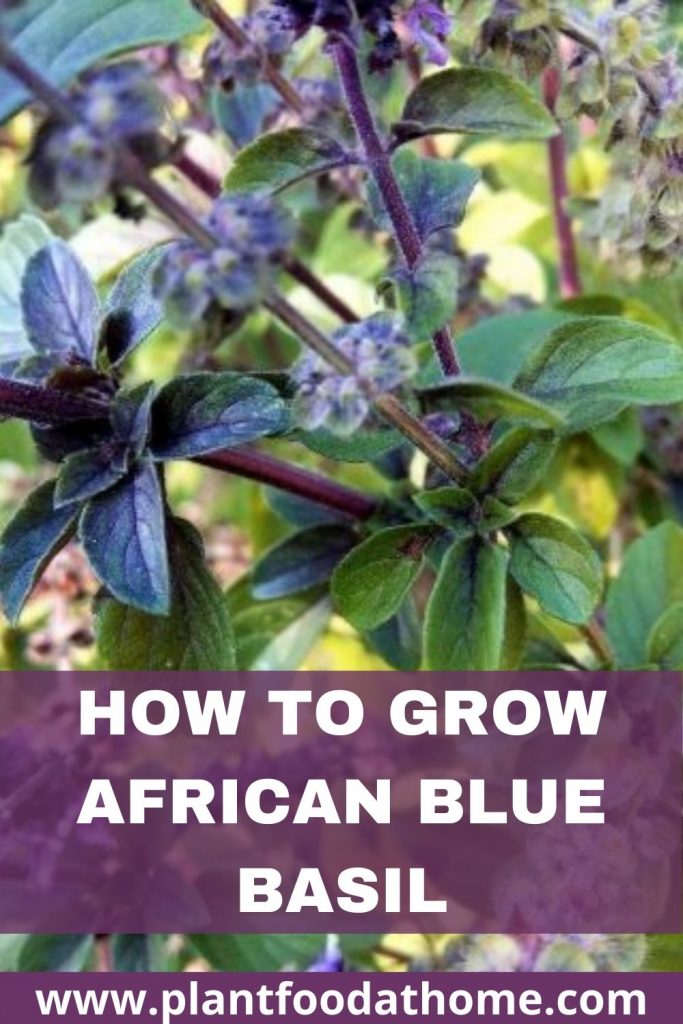Would you like to grow year-round basil? Then look no further than African blue basil. This easy-to-grow perennial basil will put on a show of flowering blooms to attract bees to your vegetable garden while being entirely edible. So let’s dig into growing African blue basil plants and explore recipe ideas for using the herb at home.
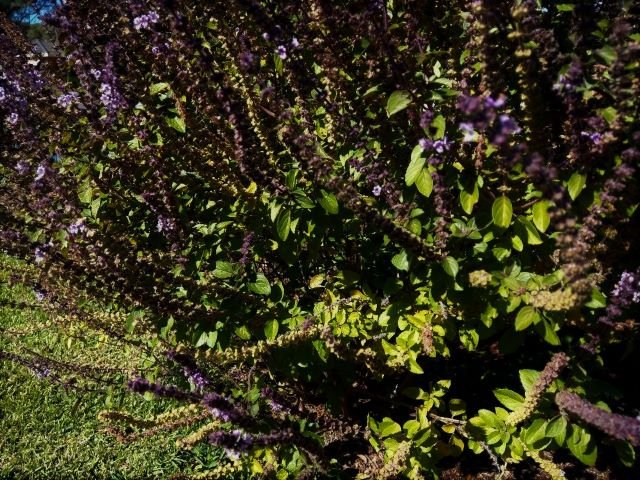
Related: 7 Basil Pests (And How to Get Rid of Them!)
Table of Contents
What is African Blue Basil?
African blue basil belongs to the Lamiaceae family, a cross-bred variety that comes from camphor basil and dark opal basil. It’s a perennial plant and flowers profusely pretty much year-round, so as well as being an edible plant, it is a wonderful beneficial insect-attracting plant. In cooler climates, African blue basil can be grown as an annual herb.
It has a powerful camphor aroma, which was inherited from the camphor basil. And most often used as a seasoning in soups, salads, sauces, and pesto as well as many other dishes including those with both vegetables, meat, chicken, and fish. It has a much stronger flavor when compared to sweet basil, so only a few leaves will add a lot of flavor.
All parts of the African blue basil plant are edible including the flower, leaves, and stems.
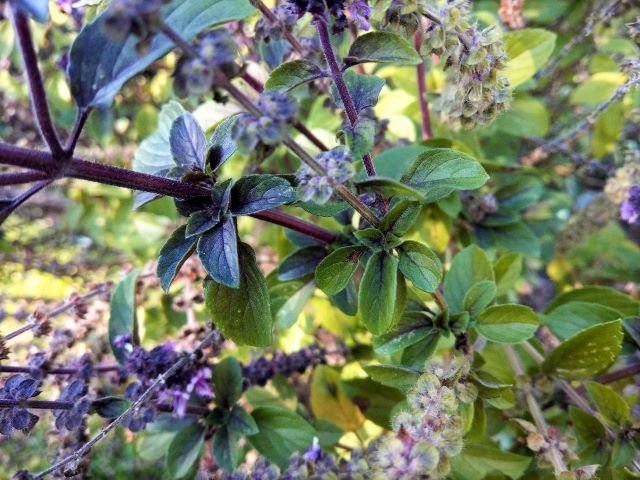
African blue basil leaves vary in size, depending on how mature the plant is. The leaves are dark purple when they are young, and slowly turn green as they mature, retaining its purple veins. They have long, purple-green stems that have purple buds that bloom lavishly into lavender purple-colored flowers. But interestingly, these plants are sterile which means they do not produce seeds.
The plant can grow to 51 inches (1.3 meters) high and wide.
How to Grow African Blue Basil Plant
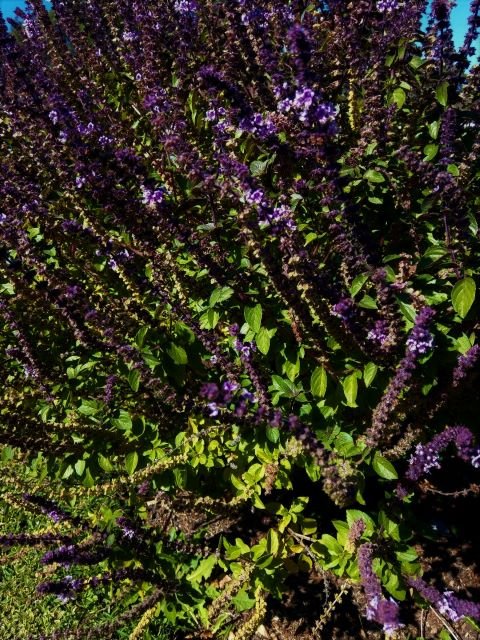
Ideal Climate for Growing African Blue Basil
The best growing climate for African blue basil is subtropical to tropical and the plant enjoys some humidity. So if you live in a climate with temps between 68-95°F (20-35°C), then African blue basil will thrive.
Winter temperature dipping below 40°F (4°C) is getting too cold for African blue basil. In areas affected by frost and very cold winters, African blue basil can be grown in pots or contains and overwintered indoors. It doesn’t like very cold weather nor too much moisture.
However, these conditions are making the plant sound fragile and in my experience, it is actually a very hardy plant.
Best Soil for Growing African Blue Basil
The soil needs to be well-drained loamy soil and a pH of 6.0 to 7.0, though this plant is really very tolerant and will grow in less than ideal soil conditions. Amending the soil with compost and aged manure prior to planting will help increase soil fertility and provide the best conditions for growing.
Sun Requirements for African Blue Basil
Being a subtropical to tropical plant, African blue basil requires full sun of at least six to eight hours daily. So choose the sunniest spot in the garden to grow African blue basil. It will also grow in partial shade if required.
Water Requirements for African Blue Basil
Once established in the garden, African blue basil needs an inch of water each week. Watering once a week helps the roots grow and keeps the soil moist. Plants grown in pots or containers tend to dry out faster so it’s best to check the soil and water them when the soil starts to dry out.
Fertilizer for African Blue Basil
You can use an organic herb fertilizer at the start of the growing season and then after a month from planting. Or instead, you can use compost and aged manure which will provide the nutrients the soil needs in order for the plant to grow well.
Caring for African Blue Basil Plant
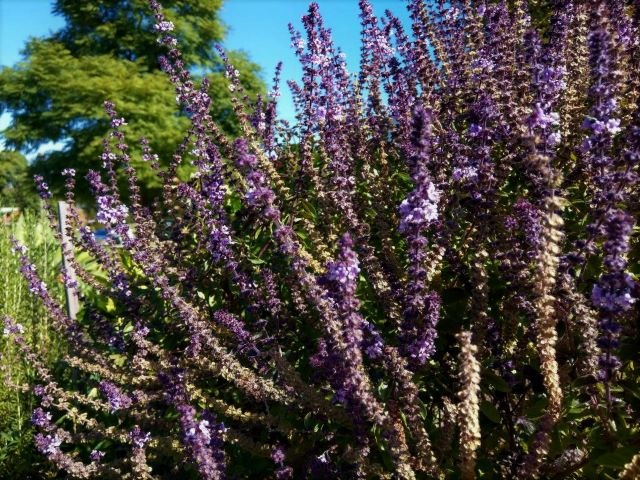
Although pruning is not required, pruning and harvesting the leaves helps African Blue basil grow, keeps the plant in check, and helps keep the shape of the plant.
If your African blue basil plant starts to look too overgrown, it can be cut back hard and it will regrow fresh foliage. After a heavy prune, I find it then regrows to its former flowering glory within a few short months.
How to Propagate African Blue Basil
African blue basil is a sterile plant, so it does not produce seeds. And because of this, it can only be propagated through cuttings.
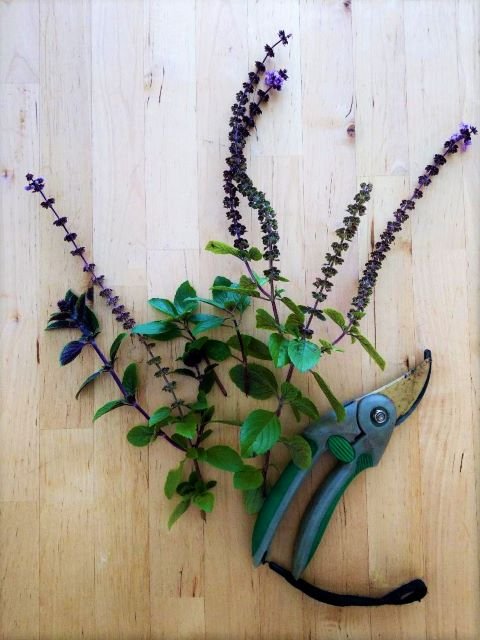
Look carefully at the mother plant to find the stems that are tender and haven’t started flowering yet. It’s best to select those that haven’t started flowering so the energy in the stem can focus on growing roots and not on the flowers. If you can’t find any stems without flowers, like mine, that’s ok. Simply remove the flower.
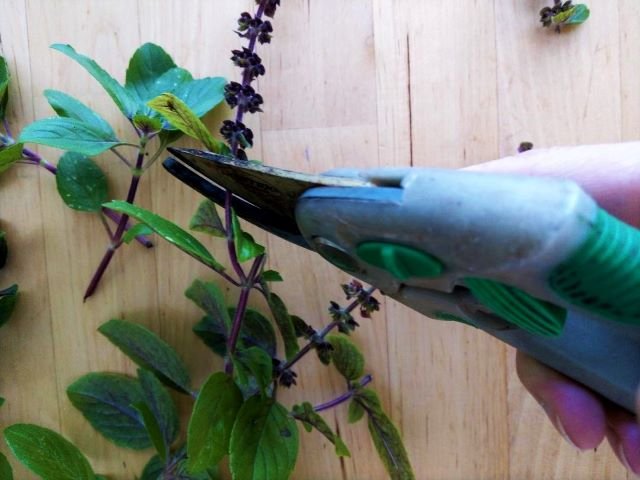
Pick stems that have 4-8 nodes (nodes are where the leaves grow). Using sharp scissors, cut the stem a quarter inch below the bottom node. Remove some of the lower leaves as this is where the roots will form.
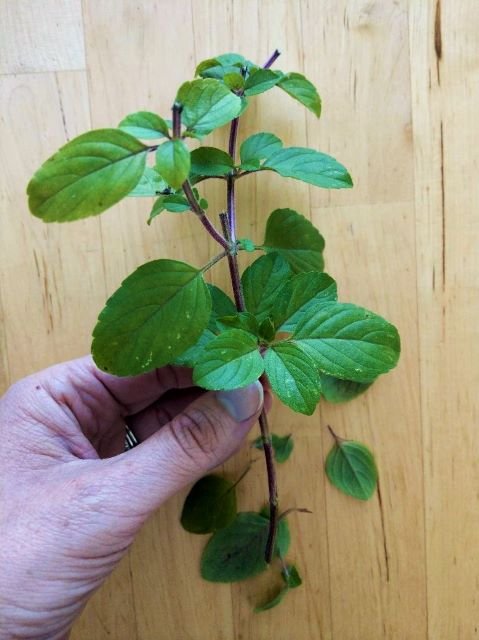
Place the cuttings in a jar of water, making sure that the water reaches the bottom 1-2 inches of the stems. Change the water every 4-5 days.
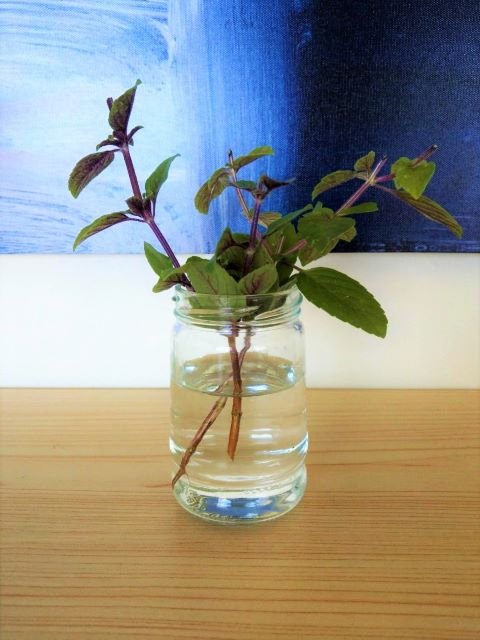
When you see roots growing, your cuttings are now ready to be planted. Fill your pots or containers with potting soil to about 2/3 full. Gently take the cuttings out of the jar and plant them into the potting mix. Cover the roots with more soil until it fills up the pot. Carefully pat them down to make them secure. And water in well.
Over the next 1-2 weeks, keep the pots watered and place them in a bright area out of direct sunlight. During this time, they should become well established and grow new roots.
You can also plant them directly in the garden. They should be spaced out 18-24 inches (45-60cm) between plants because given the right growing conditions they will grow to 51 inches (1.3 meters) tall and wide.
African Blue Basil Plant Uses and Recipes
African Blue basil not only has edible uses but medicinal uses too. Some medical uses of this plant include treating colds, fever, headaches, bacterial infections, parasites, and gastrointestinal problems. It is an insect repellent too. Its oil is used to make bug sprays.
And if you’re looking for ways to use African blue basil in your cooking, here are some recipes to try:
- African Blue Basil Vinaigrette Recipe
- African Blue Basil and Lavender Pesto
- African Blue Basil-infused Chicken & Kale Soup
Storing African Blue Basil
For the best flavor, harvest African blue basil leaves and flowers on the day you intend to use them. However, if you need to store them, wrap the leaves in a paper towel and place them in a plastic bag. Store in the refrigerator for 1-3 days.
Conclusion
African blue basil is a great addition to your garden or to your collection of potted herbs. It provides delicious flavor for your dishes with the added benefit of attracting lots of bees to your garden to help pollinate the rest of your edible garden. And if you live in the right climate, African blue basil can be grown year-round for delicious basil whenever you want it.
Some Favorite Gardening Products
- King Bird Raised Garden Bed
- AeroGarden Bounty Indoor Hydroponic Herb Garden
- Sloggers Waterproof Garden Gum Boots
- Felco Garden Pruners
Further reading:
- Growing Basil Tips: How To Grow Basil At Home
- 7 Reasons Basil Leaves Turn Yellow – With Solutions!
- How To Grow Mint: Complete Guide To Growing Mint At Home
- How To Grow Cilantro: Tips For Growing Cilantro
- Spots on Oregano Leaves? Causes and Solutions
- Dying Dill Plant? Common Causes and Solutions
